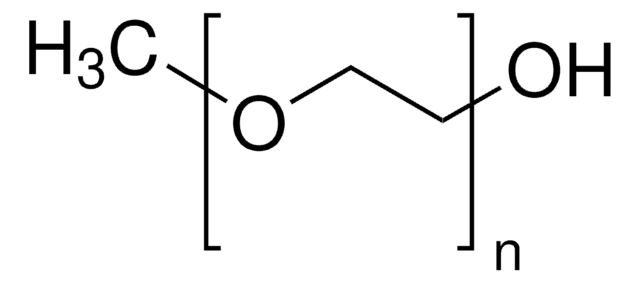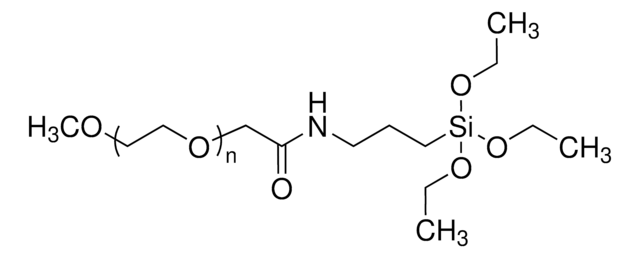901645
Methoxy poly(ethylene glycol) KAT
PEG average Mn 20,000
Synonym(s):
KAT PEG 20k, mPEG KAT
Sign Into View Organizational & Contract Pricing
All Photos(2)
About This Item
Linear Formula:
H3CO[CH2CH2O]nCH2CH2O(C6H3BF3KNO)
UNSPSC Code:
51171641
NACRES:
NA.23
Recommended Products
form
powder or solid
mol wt
PEG average Mn 20,000
PEG ~20,000 Da
color
off-white to pale yellow
storage temp.
2-8°C
Looking for similar products? Visit Product Comparison Guide
General description
Methoxy poly(ethylene glycol) KAT 20K (mPEG KAT 20K) is a monofunctional, methyl ether PEG featuring a terminal potassium acyltrifluoroborate for facile, rapid functionalization. Potassium acyltrifluoroborates (KATs) are stable functional groups that undergo rapid amide-forming ligations with hydroxylamines in aqueous media, in the presence of unprotected functional groups. In addition to its compatibility, these reactions proceed relatively quickly, lending to their use with sensitive biological reagents. This conjugation reaction offers a new approach to the synthesis of complex molecules without the complication of side reactions, such protein-polymer conjugates. KATs also undergo amide or imide-forming ligations in acidic conditions when reacted with primary amines or amides, respectively, as an alternative to classical acylation chemistry.
Storage Class Code
11 - Combustible Solids
WGK
WGK 3
Flash Point(F)
Not applicable
Flash Point(C)
Not applicable
Choose from one of the most recent versions:
Certificates of Analysis (COA)
Lot/Batch Number
Sorry, we don't have COAs for this product available online at this time.
If you need assistance, please contact Customer Support.
Already Own This Product?
Find documentation for the products that you have recently purchased in the Document Library.
Potassium Acyltrifluoroborate (KAT) Ligations are Orthogonal to Thiol-Michael and SPAAC Reactions: Covalent Dual Immobilization of Proteins onto Synthetic PEG Hydrogels.
Mazunin D, et al.
Helvetica Chimica Acta, 100(2) (2017)
Alberto Osuna Gálvez et al.
Journal of the American Chemical Society, 139(5), 1826-1829 (2017-01-25)
Current methods for constructing amide bonds join amines and carboxylic acids by dehydrative couplings-processes that usually require organic solvents, expensive and often dangerous coupling reagents, and masking other functional groups. Here we describe an amide formation using primary amines and
Fumito Saito et al.
ACS chemical biology, 10(4), 1026-1033 (2015-01-13)
Chemoselective ligation reactions have contributed immensely to the development of organic synthesis and chemical biology. However, the ligation of stoichiometric amounts of large molecules for applications such as protein-protein conjugates is still challenging. Conjugation reactions need to be fast enough
Hidetoshi Noda et al.
Journal of the American Chemical Society, 136(15), 5611-5614 (2014-04-02)
The identification of fast, chemoselective bond-forming reactions is one of the major contemporary challenges in chemistry. We show that chemoselective amide-forming ligations of potassium acyltrifluoroborates (KATs) and O-carbamoylhydroxylamines proceed in the presence of all unprotected functional groups with a second-order
Amide-forming ligation of acyltrifluoroborates and hydroxylamines in water.
Aaron M Dumas et al.
Angewandte Chemie (International ed. in English), 51(23), 5683-5686 (2012-04-28)
Our team of scientists has experience in all areas of research including Life Science, Material Science, Chemical Synthesis, Chromatography, Analytical and many others.
Contact Technical Service


